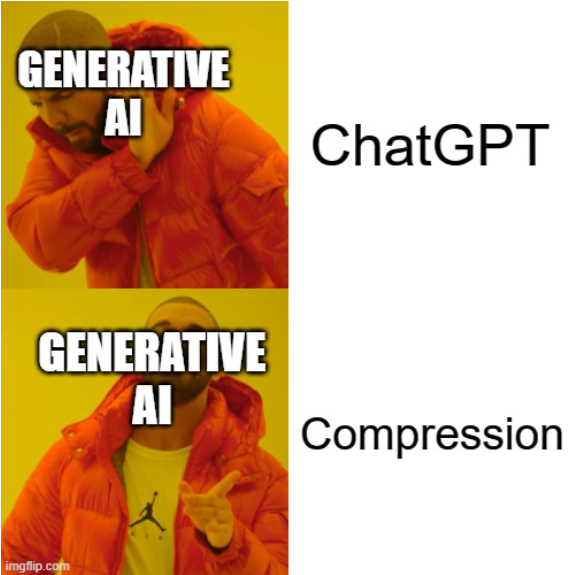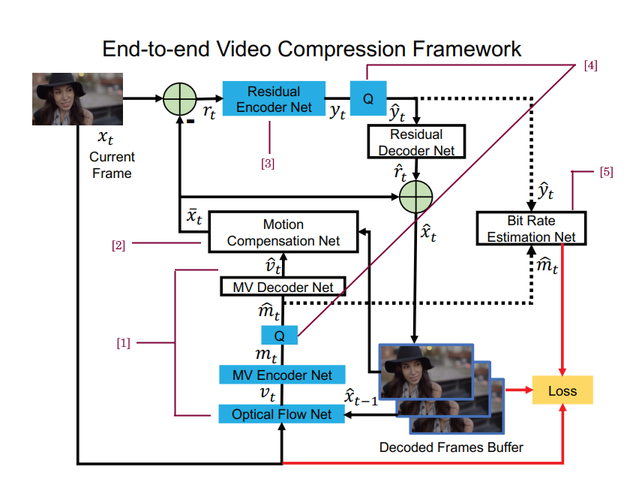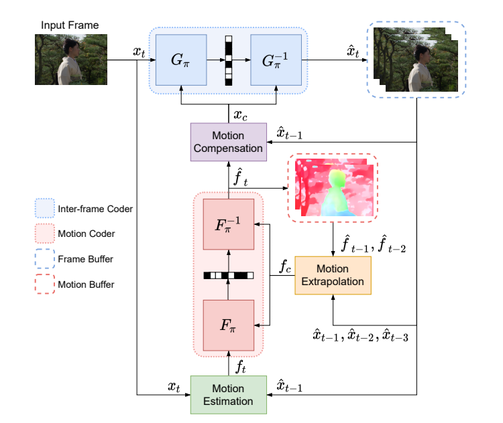I few weeks ago, I wrote a blog post on H.265 vs AV1: The Battle for Efficient Video Compression!. Here I talked about the differences between H.265 and AV1 video compression standards and some experiments I did to compare them. In this post, I will introduce the use of deep generative models for video compression and review some recent papers that apply this technique to various applications. Video compression is a fundamental problem in computer vision and multimedia, as it aims to reduce the storage and transmission costs of visual data while preserving its quality and information content. Traditional video compression methods rely on hand-crafted transforms, quantization schemes, and entropy coding algorithms that are designed based on human perception and signal processing principles. However, these methods have limitations in handling complex and diverse visual data, especially at low bitrates.

Generative AI models have taken the world by storm in the recent history with GPT based models, LLMs etc. However, generative models, such as variational autoencoders (VAEs) and generative adversarial networks (GANs), offer more than just allowing you to talk to ChatGPT when you are alone!!
These models offer a new paradigm for video compression, as they can learn data-driven representations that capture the underlying structure and distribution of the visual data. Moreover, they can leverage powerful neural networks to perform nonlinear transforms, quantization, and entropy coding in an end-to-end manner. The main idea of deep generative models for video compression is to encode the input video into a compact latent representation that can be decoded by a generative model to reconstruct the original or a high-quality approximation of it. The latent representation can be further discretized and entropy coded to produce a compressed bitstream that can be transmitted or stored.
Research Papers
In this section, I will review four papers that have been published in the last few years. I have not chosen these papers as just the state-of-the-art, but I have chosen this papers because they each present a unique and different approach to the same problem.
[1] DVC: An End-to-end Deep Video Compression Framework
This paper by Lu et al., is the first paper to propose an end-to-end video compression deep model that jointly optimizes all the components for video compression. Simply put, they take the traditional video compression pipeline and replace each component with a neural network.
Specifically, learning-based optical flow estimation is utilized to obtain motion information and reconstruct current frames. Then two auto-encoder style neural networks are employed to compress the corresponding motion and residual information.
The model consists of several key components: motion estimation and compression, motion compensation, transform, quantization and inverse transform, entropy coding, and frame reconstruction. To make it simple to understand, I have taken frames from the paper and annotated the image with the corresponding component.
 |
|---|
| Figure A.1 [1] |
- Motion estimation and Compression - a CNN model is used to estimate optical flow, which is considered as motion information. An motion vector encoder-decoder network is proposed to compress and decode optical flow values.
- Motion compensation - this network is designed to obtain the predicted frame based on optical flow.
- Residual Encoding - The residual information between the original frame and predicted frame is encoded by a residual encoder network. A highly non-linear neural network is used to transform residuals to corresponding latent representation.
- Quantization - The latent representations are required to be quantized before entropy coding.
- Bit Rate Estimation Net - To estimate bit rates of generated latent representations, CNNs are used to obtain probability distribution of each symbol.
Finally, frame reconstruction is performed by adding predicted frame and reconstructed residual.
This paper is interesting because it does not use an explicit Generative Model, but the architecture is similar to an auto-encoder in various stages of the pipeline. This paper has become the guiding light for many other papers in this area which improve upon this basic architecture.
[2] Deep Generative Video Compression
This paper comes from Disney Research. In this paper Han et al., builds upon the work done in Variation Auto-Encoders (VAE) for neural image compression and use it to model sequential data and jointly learn to transform the original sequence into a lower-dimensional representation as well as to discretize and entropy code this representation according to predictions of the sequential VAE.
This paper was the first to propose a core generative approach for video compression. If you want to get into the maths of it all, I would suggest you to read the paper. Shown below is the high-level operational diagram of the proposed compression codec. A video segment is encoded into per-frame latent variables \(z_t\) and also into a per-segment global state \(f\) (which I have omitted from the diagram for simplicity) using a VAE architecture. The latent variables are then quantized and arithmetically encoded into binary according to the respective prior models. To recover an approximation to the original video, the latent variables are arithmetically decoded from the binary and passed through the neural decoder.
 |
|---|
| Figure A.2 [2] |
The most interesting part of the paper is the use of a temporally-conditioned prior distribution parameterized by the VAE to code the latent variables associated with each frame. This is what separates this paper from full compression algorithms.
The proposed architecture also splits up the latent code into global and local variables which I have removed from the diagram. The global variables are inferred from all video frames in a sequence and may contain global information, while the local variables are only inferred from a single frame.
This paper is a very good read and I would recommend it to anyone who is diving into the world of generative models.
[3] Self-Conditioned Probabilistic Learning of Video Rescaling
This paper by Tian et al., is a very interesting paper becauses this is a video rescaling algorithm instead of video compression. However, they propose an application of their algorithm to video compression that can be trained end-to-end.
The authors propose a self-conditioned probabilistic framework, which simultaneously learns paired downscaling and upscaling procedures. The rescaling framework consists of three components:
- a frequency analyzer,
- a spatial-temporal prior network (STP-Net), and
- a frequency synthesizer.
During the downscaling procedure, the frequency analyzer converts a high-resolution video into low-frequency and high-frequency components. The low-frequency component is quantized to produce a low-resolution video, while the high-frequency component is discarded. During the upscaling procedure, the STP-Net predicts the probability density function of the high-frequency component conditioned on the low-resolution video - \(p(f_h|x_l)\), by modelling a Gaussian Mixtures Model (GMM).
A sample of the high-frequency component is then drawn from this distribution and combined with the low-resolution video using the frequency synthesizer to reconstruct the original high-resolution video.
In terms of video compression, the paper claims that compressing the down-scaled videos using a standard video codec like H.265 can achieve a better compression ratio than compressing the original high-resolution videos. But since, video codecs are non-differential, the authors propose a differentiable surrogate using a DNN to approximate the H.265 codec. This is shown in the image below.
 |
|---|
| Figure A.3 [3] |
[4] CANF-VC: Conditional Augmented Normalizing Flows for Video Compression
This paper by Ho et al., proposes a video compression framework using Conditional Augmented Normalizing Flows (CANFs) which are an extension of Normalizing Flows (NFs) to the conditional setting. Normalizing flows are generative models that produce tractable distributions by transforming a simple probability distribution into a more complex and flexible one through a sequence of invertible and differentiable functions. These functions must have analytical inverses and follow the rule for change of variables. By repeatedly applying the rule for change of variables, the initial density ‘flows’ through the sequence of invertible mappings. If you want to learn more about Normalizing Flows, I recommend you to watch this video from the University of Waterloo.
The authors suggest the use of Augmented Normalizing Flows (ANFs) since its a more generalized generative model and has superior expressive power to VAEs. They draw this idea from ANFIC[6] which uses ANFs for image compression.
 |
|---|
| Figure A.4 [4] |
The architecture of this approach has two major components:
- CANF inter-frame coder: which encodes a video frame conditionally, give the motion compensated frame - \(p(x_t | x_c)\)
- CANF motion coder: which shares a similar architecture to the inter-frame coder, with the coding frame replaced by an optical flow map and the motion-compensated frame replaced by an extrapolated flow map. The flow map is estimated by PWC-Net and serves to warp the reference frame, with the warped result further enhanced by a motion compensation network.
The decoding process updates the motion-compensated frame successively to reconstruct the target frame. The quantized latent is then recovered and decoded to update the motion-compensated frame, which is then encoded conditionally based on its previous state in order to update the latent. This process is repeated until the reconstructed version of the target frame is achieved.
This is a very well written paper and the above summary does not justify the complexity of the paper. I would recommend you to read the paper if you are interested aboyut this approach.
References
[1] Lu, Guo, et al. “Dvc: An end-to-end deep video compression framework.” Proceedings of the IEEE/CVF Conference on Computer Vision and Pattern Recognition. 2019.
[2] Lombardo, Salvator, et al. “Deep generative video compression.” Advances in Neural Information Processing Systems 32 (2019).
[3] Tian, Yuan, et al. “Self-conditioned probabilistic learning of video rescaling.” Proceedings of the IEEE/CVF international conference on computer vision. 2021.
[4] Ho, Yung-Han, et al. “Canf-vc: Conditional augmented normalizing flows for video compression.” Computer Vision–ECCV 2022: 17th European Conference, Tel Aviv, Israel, October 23–27, 2022, Proceedings, Part XVI. Cham: Springer Nature Switzerland, 2022.
[5] Ho, Yung-Han, et al. “Anfic: Image compression using augmented normalizing flows.” IEEE Open Journal of Circuits and Systems 2 (2021): 613-626.